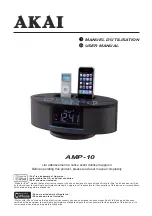
response at the listening position can be
determined by the same means. When com-
paring the results, the following items should
be noted.
1. High frequency roll-off
This is due to the following physical factors:
• Increasing room and air absorption with
higher frequencies.
• Increasing loudspeaker and microphone
directivity with increasing frequency.
2. Low frequency irregularities.
These are caused by:
• Insufficient standing wave absorption in
the control room.
• Reflections from nearby boundaries
(Floor, ceiling, walls) interfering with
direct sound.
Incorrect vertical speaker alignment can
cause interference dips at the upper crosso-
ver frequency (around 3.2 kHz). Hence care
should be taken aiming the speaker correctly
towards the listening position. (See Fig 3.)
Overload indicators
Each loudspeaker is provided with two LED’s
marked ‘CLIP PROTECT (FAULT)’ and
‘READY’. The green ‘READY’ LED indicates
that the amplifier system power is switched
on, and that the speaker is ready for use. The
red ‘CLIP PROTECT (FAULT)’ LED indicates
that the amplifier system is overloaded or
that the driver protection circuit is activated. If
the red LED lights, reduce the signal level so
that the LED stops blinking. If this LED stays
lit constantly, the amplifier thermal protection
circuitry has activated. Let the amplifier cool
down, and ensure that the amplifier is ade-
quately ventilated.
Maintenance
There are no user serviceable parts within
the amplifier unit. Any maintenance of the
unit should only be undertaken by qualified
service personnel. Ensure that only fuses
of the appropriate voltage and current rat-
ings are used if a fuse has to be replaced.
REMEMBER to disconnect the power supply
by removal of the mains cable before chang-
ing a fuse. Clean the amplifier unit’s air filter
every six months, or more frequently in dusty
environments. The air filter is located behind
the grille, found to the left of the front panel.
The air filter can be cleaned with a vacuum
cleaner without removing the grille.
Safety considerations
Although the HT330A has been designed in
accordance with international safety stand-
ards, to ensure safe operation and to main-
tain the instrument under safe operating con-
ditions, the following warnings and cautions
should be observed:
• Servicing and adjustment must only
be performed by qualified service
personnel. The loudspeaker or the
amplifier must not be opened.
• The amplifier must only be connected
to mains socket outlet with a protective
earthing connection.
• Do not use the amplifier with
an unearthed mains cable as this may
compromise electrical safety.
• Do not expose the loudspeaker or the
amplifier to water or moisture. Do not
place any objects filled with liquid, such
as vases, on the loudspeaker or near it.
• Do not place naked flame sources like
lighted candles on or near the
loudspeaker or the amplifier.
• This loudspeaker is capable of
producing sound pressure levels
in excess of 85 dB, which may cause
permanent hearing damage.
• Proper ventilation of the amplifier is
necessary to maintain sufficient cooling.
Ensure that air flows freely into the
openings on the amplifier front panel
and that the space behind the amplifier
is sufficiently ventilated to dissipate the
generated heat.
• Note that the amplifier is not completely
disconnected from the AC mains service
unless the mains power cord is removed
from the amplifier or the mains outlet.
Guarantee
This product is guaranteed for a period of
one year against faults in materials or work-
manship. Refer to supplier for full sales and
guarantee terms.
EC Declaration of Conformity
This is to certify that Genelec HT330A
Control Room Monitoring System conforms
to the following standards:
Safety:
EN 60065 / IEC 60065:1998 7th Edition
EMC:
EN 55013: (2001)
EN 55020: (1994), A11: (1996), A12: (1999),
A13: (1999), A14: (1999)
EN 61000-3-2 (2000)
EN 61000-3-3 (1995)
The product herewith complies with the
requirements of The Low Voltage Directive
73/23/EEC, EMC Directive 89/336/EEC and
93/68/EEC
Signed:
Ilpo Martikainen
Position: Managing Director
Date:
16-January-2006
























